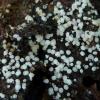
21-11-2015 21:38
Simon KennedyCan anyone help with a copy of the above.? It is a

29-11-2015 22:19
Hi,here is a conidial state on dead D. tristachyum

29-11-2015 12:57
 Joop van der Lee
Joop van der Lee
I did find Sporormiella heptamera on cow dung and
Calycina ?
Patrice TANCHAUD,
15-09-2015 01:21
sur bois mort au sol en zone humide avec présence majoritaire d'aulnes. Apothécies inférieures à 1 mm, immuables. Spores 4,5-7 x 2,2-3 µm. Asques 55-60 µm. Sommet des asques observé dans le melzer.
J'envisagerais bien Calycina guttulifera ? Merci d'avance pour vos avis.
On the ground dead wood in wet areas with majority presence of alders. Apothecia less than 1 mm, immutable. Spores 4,5-7 x 2,2-3 µm. Asci 55-60 µm. Summit asci observed in Melzer.
I would consider Calycina guttulifera well ? Thank you in advance for your advice.
Patrice
Hans-Otto Baral,
15-09-2015 11:18

Re : Calycina ?
Could you make a closeup of apothecia?
I first thought you refer to C. languida. But your idea with guttulifera is not bad!
I first thought you refer to C. languida. But your idea with guttulifera is not bad!
Patrice TANCHAUD,
15-09-2015 11:34
Hans-Otto Baral,
15-09-2015 11:52

Re : Calycina ?
a bit better ....
It may be that C. languida has not such globulosa on the flanks, but C. guttulifera has.
Zotto
It may be that C. languida has not such globulosa on the flanks, but C. guttulifera has.
Zotto
Patrice TANCHAUD,
15-09-2015 11:58
Re : Calycina ?
Yes, and spores also better match with your DVD for C. guttulifera.
Patrice
Patrice
Hans-Otto Baral,
01-12-2015 10:02

Re : Calycina ?
Bonjour Patrice
as you know, we received yesterday the sequence of presumably this fungus from Guy. As it was only labelled as "Calycina" I wasn't sure at first. The problem is that the sequence is very different from that I already have (HB 6787).
the two collections are very similar in the spores (except that yours lacks the sheath), exactly the same length 4.5-7 and almost the same width! Only your rings reacted blue while mine purely red, and also your paraphyses seem to be without VBs and not densely septate below. It is a mess with these small discos!!
Did you send Guy any collection data along with the specimen? Unannotated sequences remain always a bit doubtful.
Zotto
as you know, we received yesterday the sequence of presumably this fungus from Guy. As it was only labelled as "Calycina" I wasn't sure at first. The problem is that the sequence is very different from that I already have (HB 6787).
the two collections are very similar in the spores (except that yours lacks the sheath), exactly the same length 4.5-7 and almost the same width! Only your rings reacted blue while mine purely red, and also your paraphyses seem to be without VBs and not densely septate below. It is a mess with these small discos!!
Did you send Guy any collection data along with the specimen? Unannotated sequences remain always a bit doubtful.
Zotto
Patrice TANCHAUD,
01-12-2015 11:29
Re : Calycina ?
Hi Zotto,
I send data collection to Guy. If you want, I still have some dry ascos.
Patrice
I send data collection to Guy. If you want, I still have some dry ascos.
Patrice
Hans-Otto Baral,
01-12-2015 11:36

Re : Calycina ?
I think that Guy will finally send me the remaining specimen. No matter when this will be, presently I have no time to go deeper in this.
Thanks in any case for sending the material to him!
Zotto
Thanks in any case for sending the material to him!
Zotto



 Doc1-0013.pdf
Doc1-0013.pdf